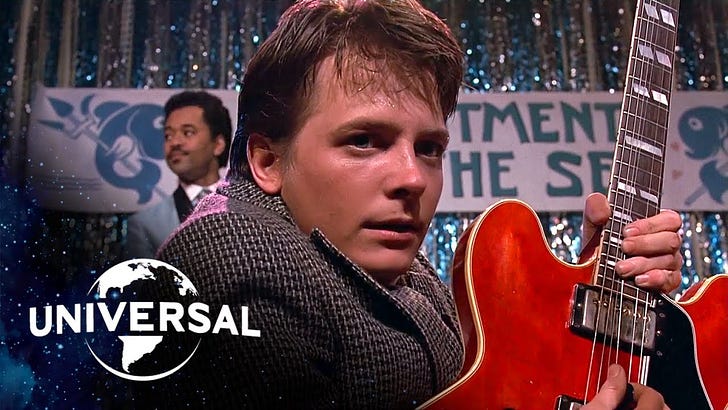In Scriptnotes episode 279, John and Craig discuss how musicals use songs to provide the inner voice of a character. They also look at techniques that bring out those inner desires in non-musical films. But what about those gray areas in-between, when characters in a non-musical get caught up in a performance?
Take the Enchantment Under the Sea dance in Back to the Future:
Think about what the audience already knows before this moment in the film:
The guitarist from the band hurt his hand and can’t play. The dance will end without the band.
It’s been built up that George and Lorraine kiss for the first time at this dance. They have not kissed yet.
Marty needs them to kiss in order to continue to exist.
Marty plays guitar (and he likes to shred).
All the ingredients are here to create a musical moment that feels in character and cohesive with the rest of the story. Marty is essential to the conflict, but isn’t the driver (because he can’t just smoosh his future parents’ faces together), and we get to witness the payoff of a moment the movie references multiple times. Stephanie Young has a longer ode to the scene, and how all its pieces come together.
In When Harry Met Sally, Harry gets Sally singing along with him on a karaoke machine to “Surrey with the Fringe on Top” from Oklahoma.1 It’s grounded by Harry and Sally’s need to pick out a present, as well as Harry’s compulsion to joke around. It starts as a fun moment of friendship, but gets purposefully undercut when Harry’s ex-wife shows up with her new partner. The backing track for a song about new love keeps playing under the awkward conversation between exes.
This comes back in another scene when Harry goes on a tirade about his belief all couples are doomed. The Sharper Image karaoke scene isn’t out of character behavior for Harry or Sally, but it’s a different type of scene, which helps it make an impression for when it comes back later.
Sticking with Oklahoma, i’m thinking of ending things features a final act pivot that includes a dream ballet and a performance of “Lonely Room.” The movie as a whole is twisty and surreal, but these references are grounded by frequent references to Oklahoma earlier in the film. J.S. Lewis dissects the film’s numerous references, tying together the opening and ending of the film. Dawn Davis Loring offers a detailed take on the Dream Ballet in Oklahoma and what connects it with i’m thinking of ending things.
Heading back to a less off-kilter reality, Pretty in Pink features a character defining dance scene when Duckie lip syncs to Otis Redding. Whether you see Duckie as a cautionary tale (via Kevin Smokler) or seen through the wrong lens (via Daniel M. Lavery), the moment acts like a trailer for a character. It is a sweaty, tryhard explosion that exists because Jon Cryer consulted Kenny Ortega on the choreography.
Is there a place for musical performance in your non-musical? How do the characters connect to music? Is there a place or event in the story where a music performance is happening? Is there something the characters are feeling that they can’t put in to words?
👋 Are you new here?
Inneresting is a weekly newsletter about writing and things that are interesting to writers. Subscribe now to get more Inneresting things sent to your inbox.
⏱️ Time to Write Sprint
Each week we post a comment thread for writers to meet up, cheer each other on, and put some words on the page with a Write Sprint.
What’s a Write Sprint?
John wrote up an explanation, but here’s the short version: Set a timer for 60 minutes, close down all distractions, and do nothing but write until that timer goes off.
Sometimes that’s all it takes to get some momentum going with your writing: You set aside this time for writing and nothing else, so you’d better use it!
Shout out to Brian Matusz, Elyse Moretti Forbes, and Aimee Link for sprinting with us last week!
Previously on Inneresting…
In case you missed it, in last issue’s most clicked link Jessica Hagy shares a set of questions to ask yourself and others, with accompanying Venn diagrams.
What else is inneresting?
Willa Paskin pieces together the story of OK Soda, the Coke product marketed as an ironic “beverage.”
Liam Thompson experiments with spending a week without modern conveniences and relying exclusively on 80s technology. His conclusion? “I don’t want to leave the 80s. It’s just been no notifications and pizza.”
Ethan Warren on a divisive musical moment from Magnolia that was done, in part, to celebrate Aimee Mann.
And that’s what’s inneresting this week!
Inneresting is edited by Chris Csont, with contributions from readers like you and the entire Quote-Unquote team.
Are you enjoying this newsletter?
📧 Forward it to a friend and suggest they check it out.
🔗 Share a link to this post on social media.
🗣 Have ideas for future topics (or just want to say hello)? Reach out to Chris via email at inneresting@johnaugust.com, Mastodon @ccsont@mastodon.art, or Bluesky @ccsont.bsky.social
Post-Credits Scene
Karaoke, in general, is one way music often gets injected into non-musical stories to help characters express their feelings.



